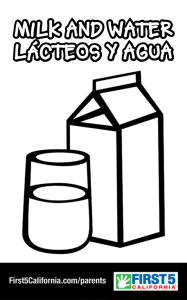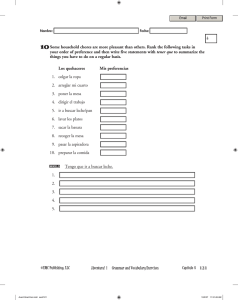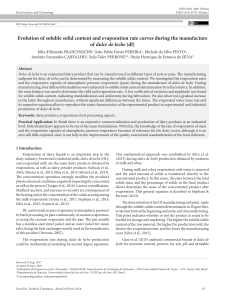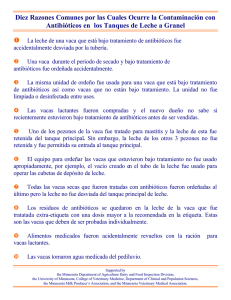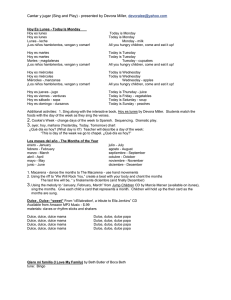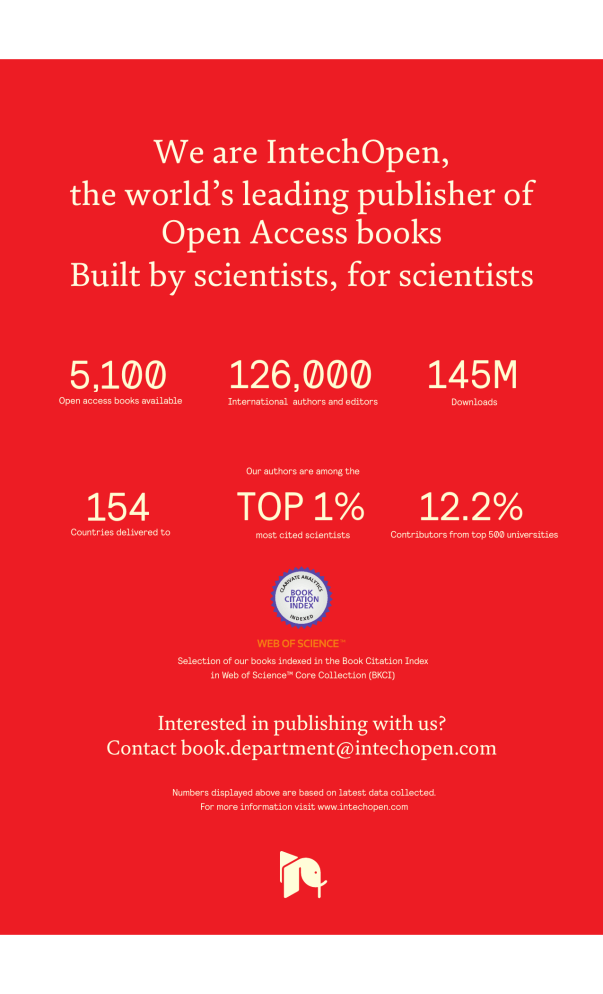
We are IntechOpen, the world’s leading publisher of Open Access books Built by scientists, for scientists 5,100 126,000 145M Open access books available International authors and editors Downloads Our authors are among the 154 TOP 1% 12.2% Countries delivered to most cited scientists Contributors from top 500 universities Selection of our books indexed in the Book Citation Index in Web of Science™ Core Collection (BKCI) Interested in publishing with us? Contact book.department@intechopen.com Numbers displayed above are based on latest data collected. For more information visit www.intechopen.com Chapter Dulce de Leche—Chemistry and Processing Technology Rodrigo Stephani, Júlia Francisquini, Ítalo Tuler Perrone, Antônio Fernandes de Carvalho and Luiz Fernando Cappa de Oliveira Abstract Originally hailing from Latin America, dulce de leche (DL) is one of the most widely manufactured dairy products in South America, where it is marketed as a paste or bar. Due to DL’s low moisture content, the product can be safely stored at room temperature, which facilitates storage and transportation logistics. The primary ingredients used to manufacture DL are milk, sucrose, and an acidity reducer. Needless to say, the raw materials must be of good quality from reliable suppliers in order for the final product to have the desired characteristics. The milk used to make DL must be microbiologically safe, remain stable during thermal processing, and preferably exhibit a high solid content. Dulce de leche is defined as a product made with or without the addition of other food substances that is obtained from milk or reconstituted milk and added sucrose (either partially substituted or not by monosaccharides and/or other disaccharides) via concentration and heat action at normal or reduced pressure. This chapter aims to explore the chemistry, processing technology, and most common industrial practices for manufacturing DL in South America. Keywords: dairy products, Maillard reaction, milk, evaporation, manufacturing technology 1. Introduction Dulce de leche (DL) is a dairy product that has widespread success and acceptance due to its pleasant sensorial characteristics. Nutritionally, it has a high energetic value and boasts high concentration of proteins, minerals, and carbohydrates. During the manufacturing process, DL is submitted to high temperatures for long periods. This, along with the types of ingredients used in its formulation, stimulates an acceleration of the Maillard reaction rate and consequently an increase of 5-hydroxymethylfurfural index. The latter corresponds to one of the indicators used to verify the intensity of the heat treatment. DL is formulated in plants that range from small, artisanal plants to small, medium, and large industrial dairy factories. The quality of the raw material, the type of formulation used, and the technology hurdles related to a lack of standardization of time and temperature during the manufacturing process have made it difficult for brands on the Brazilian market to be standardized. 1 Milk Production, Processing and Marketing It is therefore imperative to analyze, study, and prioritize how the different ingredients, manufacturing technologies, and heat treatment intensities influence the quality and uniformity of the product. Moreover, the lack of technical and scientific literature on this product underscores the need for further studies in the domain. 2. Dulce de leche DL is a dairy product that is manufactured via heat action concentration. It is produced in small- and medium-sized dairy industries on a large scale throughout South America, particularly in Brazil and Argentina [1]. According to the most recent data from the Annual Industrial Survey (PIA) released by the Brazilian Institute of Geography and Statistics (IBGE), DL production in Brazil represents 345.19 million reais, a sum equivalent to 0.82% of dairy sector production in the country. In 2009, 50% of Brazil’s milk production was concentrated in the state of Minas Gerais, according to the Integrated Development Institute of Minas Gerais [2, 3]. Despite the importance of dulce de leche on the Brazilian market since 2007, the country has maintained a trade balance deficit for the dairy product. Argentina and Uruguay have remained the primary suppliers to Brazil [4, 5]. In 2015, the Foreign Trade Information Analysis System via Internet (ALICEWeb) determined that 95.46% of Brazil’s total DL imports came from Argentina, while 4.54% came from rom Uruguay. As to destination countries for DL in 2015, the United States of America (USA), Bolivia, Paraguay, Costa Rica, United Kingdom, Chile, Uruguay, and the Netherlands accounted for 56.37, 15, 13.92, 9.67, 2.62, 0.99, 0.81, and 0.61%, respectively. Dulce de leche is defined as a product made from milk or reconstituted milk and added sucrose (either partially substituted or not by monosaccharides and/or other disaccharides), with or without the addition of other food substances, obtained via concentration and heat action at normal or reduced pressure [6]. Regulations require DL to contain milk and/or reconstituted milk and indicate minimum and maximum values for moisture, fat, ash, and protein. DL may not contain nondairy fat or protein. It is produced by concentration of milk to which sugar, usually sucrose, has been added. In some cases, it is possible to replace part of the sucrose with glucose, which improves the texture and color while simultaneously reducing lactose crystal growth and formation and increasing product viscosity [7]. The heat and the concentration processes during DL processing can lead to a series of product defects, such as protein destabilization, which results in protein precipitation. Acidity reducers can be used to reduce or avoid precipitation, as well as enhance product color. Sodium bicarbonate is one of the most common acidity reducers used in DL production [7]. The DL sensorial characteristics such as flavor and coloring are fundamentally due to the nonenzymatic browning reaction (the Maillard reaction) that occurs during the intense thermal treatment to which the milk and sugar syrup is submitted during manufacturing. Despite the sensory benefits it imparts, this reaction can have adverse effects on the nutritional characteristics of the food, such as reducing the concentration of essential amino acids like lysine [7]. The Technical Regulation of DL classifies products according to fat content and additional ingredients as shown in Table 1. The term DL (dulce de leche) is reserved for products that do not contain fat and/or protein of nondairy origin. 2 Dulce de Leche—Chemistry and Processing Technology DOI: http://dx.doi.org/10.5772/intechopen.82677 Parameter Classification Fat content DL (6.0–9.0 g.100 g−1) DL with cream (higher than 9.0 g.100 g−1) Additional ingredients DL or DL without additional ingredients DL with additional ingredients Table 1. Dulce de leche (DL) classification for fat content and addition of other food substances. The sales terms for dulce de leche established by the Technical Regulation are as follows: a. DL b. Confectionery DL c. DL with _____ filling (in the blank with the name(s) of the product(s) added. It may optionally be called “Mixed DL.”) d.Ice Cream DL or DL for Ice Cream with __________ as appropriate, when the product is intended for making ice cream The Technical Regulation further defines the sensory requirements for paste DL consistencies, for DL without apparent crystals or in semisolid or solid form, and partially crystallized DL where the moisture does not surpass 20 g.100 g−1 of product. DL can be produced as a paste or bar. The production processes for both differ in the amount of sucrose used and in end product determination. 2.1 Paste dulce de leche DL produced for the consumer is classified as paste DL and bar DL. Paste DL, as the name would indicate, is produced as a creamy paste, with uniform texture, no crystals, a distinctive brownish color, and a characteristic taste. It is generally made to be eaten as a dessert and used in pie fillings, roll cakes, and bars, among other sweets. 2.2 Bar dulce de leche Bar DL is crystallized into blocks, which have a uniform coloration and texture. The bars are typically eaten in pieces. The difference in sweetness between paste and bar DL is determined by the total solid and sucrose content and from the manufacturing process. For paste DL, production involves a slow, manual process that induces lactose and sucrose crystallization in the product. Sucrose and lactose content is higher in the syrup used to make bar DL than it is in that used to paste DL and consequently increases crystallization. The increased crystallization is necessary for the product to become solid and firm enough to be cut and served in pieces. To this end, the original solution is subjected to a controlled-crystallization process or batching. In controlled crystallization or churning, the product undergoes intense stirring as it is slowly cooled. This process induces 3 Milk Production, Processing and Marketing the formation of numerous sucrose and lactose crystals, which ultimately alter the texture of the product. Due to the greater crystal concentration and manual stirring of bar DL, the processing time is increased, which also implies in an increase in costs (steam, electric power, ice water, etc.) and payroll. However, the higher sucrose content results in a higher yield, which can offset rising costs as long as operational losses are controlled. Figure 1 presents the compositional differences between bar and paste DL made from the same milk, with a dry matter (DM) concentration of 12.21 g.100 mL−1. The addition of sucrose to the bar DL is greater (300 kg) than that for the paste DL (200 kg), in this example. 2.3 Dulce de leche with cream According to the Technical Regulation, the term “with cream” must be included when the physicochemical fat content of a product is greater than 9.0 g.100 g−1 of DL. Although consumers enjoy the texture of DL with cream, the product is not generally manufactured on a large scale, because of its higher caloric content. Only a small number of consumers are willing to indulge and enjoy this delicacy. Figure 1. Differentiation between bar and paste DL compositions. 4 Dulce de Leche—Chemistry and Processing Technology DOI: http://dx.doi.org/10.5772/intechopen.82677 Few large manufacturers in Brazil produce this type of dulce de leche. Because the cost of manufacturing is higher, the companies that do make DL with cream need to develop specific marketing strategies because not many consumers know how to identify the difference between DL with cream and conventional paste DL. 2.4 Dulce de leche with additional ingredients DL with cocoa, chocolate, almonds, peanuts, dried fruits, cereals, and/or other ingredients (apart or mixed in), which are not thickening/stabilizing/wetting additives authorized in the Technical Regulation, must be labeled “DL with _____” with the name (s) of the product (s) added entered into the blank space. It may optionally be labeled “Mixed DL.” DL with additional ingredients has attracted consumer interest because of the new flavor opportunities it provides that can be extremely pleasing to the palate. Manufacturers have also shown great interest in DL with additional ingredients as a means to add value to specific products. There are two primary methods for adding ingredients to dulce de leche. The first is the direct addition of the product to the mass of the dulce de leche, which results in a uniform end product. These additional ingredients must be added at the end of the manufacturing process in order to be adequately heat-treated during production. The most common DL flavors found on the market are plum, peanut, coffee, chocolate, coconut, strawberry, and walnuts. These DLs are generally used to make desserts. The second type of DL with additional ingredients involves packaging a fruit jelly or compote with the DL product to allow consumers to choose flavors and mix combinations according to their own tastes. Dessert DLs with additional ingredients are very common in the southern region of the State of Minas Gerais. A large market for these products can also be found in the northeastern region of Brazil where it is considered a specialty of the region. For these DL products, seeing the product itself (and not just the packaging) is very important to consumer acceptance. Pineapple, açaí, plum, blackberry, cashew fruit, cherry, cupuassu, cherimoya, guava, kiwi, passion fruit, strawberry, grape, and peach jellies are the most common DL add-ins. It is important to note that optional additives are allowed according to Principle of Transfer of Food Additives (Codex Alimentarius Vol. 1A, 1995 Section 5.3), but their concentration in the final product must not exceed the corresponding maximum proportions permitted and, in regard to the additives indicated in the Technical Regulation, should not exceed the maximum limits authorized. 2.5 Dulce de leche for ice cream and dulce de leche for ice cream with additional ingredients DL may be labeled “DL for Ice Cream” or “DL for Ice Cream with _____” when its intended use is in the preparation of ice creams. This sales description is required when the product is added as caramel (INS 150 a, b, c, d). Production of this type of dulce de leche has also grown due to the increase in the demand for new frozen desserts. Because it is one of many ingredients used in ice cream and frozen desserts, dulce de leche manufactured for ice cream use needs to have a pronounced flavor and intense color. Moreover, characteristics that inhibit freezing need to be verified during production. Lactose crystallization plays the most important role in determining these characteristics. Manufacturing technologies that use the enzymatic hydrolysis of lactose during DL production for ice cream are recommended to inhibit crystallization. 5 Milk Production, Processing and Marketing 2.6 Confectionery dulce de leche DL that has been enhanced with authorized thickening/stabilizing additives and/or humectants allowed in the Technical Regulation are referred to as “Confectionery DL.” This market probably is probably the most competitive among DL manufacturers. It is characterized by 10-pound can packaging and large-scale manufacturing processes. Confectionery DL must meet certain requirements such as pronounced flavor (to enhance filling taste), high viscosity (for easy molding), and low microbial counts (to account for the additional manipulations involved). The technology used must address these needs, which is why thickeners and higher sucrose contents are used. The Technical Regulation allows for the addition of several thickeners; however, starch remains the most commonly used thickener (maximum of 0.5 g.100 mL−1 on milk volume). Sucrose can be used up to 30 g.100 mL−1 per milk volume. 2.7 Dulce de leche for industrial use only When DL is produced exclusively as a raw material for industrial preparation of other foods and contains a concentration of sorbic acid and/or its Na, K, or Ca salts higher than 600 mg.1000 g−1 up to 1000 mg.1000 g−1 (both expressed in sorbic acid), the label must include the term “Industrial Use Only.” 2.8 Special types of dulce de leche 2.8.1 Dulce de leche base paste and similar products Because there are no specific technical regulations for products found on the Brazilian Market such as DL Base Paste, DL Paste, and DL Candy Flavor, at time of printing, we will not include a discussion of their legislation. The use of starch and glucose is almost a requirement when manufacturing these products. It is currently possible to develop different product profiles for a variety of applications by the precise selection and inclusion of a starch in the product during manufacturing. The starches are modified in order to give the final product the plasticity, brightness, and consistency that baking and candy-making professionals expect for their fillings. In sum, modified starches with improved gelling ability have been used for this purpose, which, in addition to lowering the cost, are easy to implement in the manufacturing process. Gelling occurs during the cooling and storage phases of product production. The gelation is due to intermolecular interactions of the polymers that form a three-dimensional network and confer the viscoelastic properties on it. Gelling time depends on the formulation type, package size, and storage temperature. Average gelling in this type of DL varies from 4 to 14 days after the end of the concentration/evaporation phase. 2.8.2 Diet dulce de leche The already strong market for diet products continues to grow each year at rates that have driven some companies to specialize in the production of diet DL. The production technology for diet dulce de leche is advanced and very complex due to the limits placed on sucrose addition; these have a direct impact on the characteristics of the product both during manufacturing and after packaging. 6 Dulce de Leche—Chemistry and Processing Technology DOI: http://dx.doi.org/10.5772/intechopen.82677 Sucrose in dulce de leche influences taste, yield, consistency, brightness of the final product, and protein adherence to equipment surfaces. Thus, unlike other dairy products where sucrose is substituted for other high power sweeteners and substantially minimizes sugar withdrawal, the technology needed to make diet DL (without the addition of saccharose) calls for different ingredients that answer them. Sorbitol, pectin, modified starches, dairy proteins, and sweeteners are the most common additives used to make diet DL. 2.8.3 Milk drop (Pingo de Leite) Marketed in small drop-like pieces, milk drops have a firm coating with a soft, creamy interior. The dual texture characteristics are achieved by rapidly cooling and partially dehydrating the DL as it is poured in thin layers onto special trays. Generally, these trays have designs (company name or logo) that are embossed into the product. 3. Dulce de leche manufacturing technology Originally hailing from Latin America, dulce de leche (DL) is one of the most widely manufactured dairy products in Brazil, where it is marketed as a paste or bar. Due to DL’s low moisture content, the product can be safely stored at room temperature [8]. The primary ingredients used to manufacture DL are milk, sucrose, and an acidity reducer. Needless to say, the raw materials must be of good quality from reliable suppliers in order for the final product to have the desired characteristics. The milk used to make DL must be microbiologically safe (total bacteria count <300,000 cfu mL−1 in raw milk), remain stable during thermal processing, and preferably exhibit a high solid content (>11.4 g.100 g−1 of dry matter) [1]. Total processing time can vary from 40 minutes to 4 hours. Processing time depends on the type of equipment used and the amount of steam injected. Processing time plays an important role in a product’s viscosity, color, and flavor and ultimately determines the characteristics of the final product [7]. Processing end time for dulce de leche can be verified in two different ways: by determining the soluble solids content (above 66°Brix) or by observing how a small droplet of DL behaves when submerged in water. Once the desired solid content/ consistency is reached, the final product should be cooled to 75–80°C and then packaged while still warm in cans or glass containers that have been filled to the top to eliminate any air and prevent contamination. In general, the yield is 2.5 L/kg of DL. The product is then stored at room temperature for a period ranging from 160 to 180 days [8]. DL can either be handmade in batches or continuously produced in pans and vacuum evaporators or evaporators attached to pans. The pan used is generally a dual-ply container with a stainless steel interior and an outer wall, which lets steam pass between the two layers while also conducting heat [7]. 3.1 Open top pan The technology used to manufacture dulce de leche is determined by the equipment used. Often, quality improvement is limited not by cost or lack of skills, but by the very equipment that is used to make the product. It is possible to make DL in 30 minutes or up to 6 hours using the same volume of milk. This shows how important equipment choice can be, since time factor can directly impact the competitiveness of a specific dairy plant. 7 Milk Production, Processing and Marketing In the traditional manufacturing process (most common in Brazil), the milk and sugar mixture (syrup) is concentrated directly in double-walled stainless steel pans, through which steam flows. After the syrup has been prepared, gradual heating is applied to the liquid, which is continuously stirred. This stirring prevents the liquid in direct contact with the walls from scorching. Stirring also reduces foam formation, which allows water to evaporate more quickly from the syrup. Once the syrup reaches the desired consistency, the cooling process begins until the dulce de leche temperature has dropped to 75°C. The cooling step helps avoid high temperatures within the DL mass, which would otherwise affect the color and texture uniformity (Figure 2). Primary components of an open-top dulce de leche pan: 1. Manometer: Pressure gauge inside the steam jacket. Controls the processing time and regulates safety during processing. 2. Purge: Eliminates the condensate from the steam jacket, increasing energy exchange (heat) efficiency. 3. Stirrer: Promotes syrup movement during the concentration phase, homogenizes temperature, facilitates water evaporation, and prevents scorching. 4. Reducing box: Reduces engine rotation and transfers motion to the shaker. 5. Steam jacket: Provides indirect heat via steam circulation. It covers approximately one-third of the area of the tank. 6. Security valve: Opens and expels steam when the pressure in the pan is above the working pressure of the equipment in order to prevent excess pressure. 7. Reducing pressure valve: Keeps the pressure in the steam jacket constant to avoid levels above safe working pressure. 8. Exhaust system: Accelerates the concentration process by removing excess steam from interior of the pan to prevent it from condensing. 9. Lid: The pan lid usually provided at the time of purchase by the pan manufacturer. However, this device is not often used in many plants, especially those where is no exhaust installed in the equipment (though this is not recommended). Using the open pan without a lid can lead to foreign objects and debris falling into the product during processing, mainly due to operator carelessness. Operating the system without a lid can also lead to unprotected bulb breakage and lining, top, accessory, and other equipment (stirrer locks and set screws) deterioration. 3.2 Vacuum evaporation Vacuum evaporation consists of withdrawing water by applying energy in the form of heat to milk in a pressurized chamber that is lower than atmospheric pressure. This process promotes evaporation at temperatures between 40 and 75°C, which minimizes the changes caused to milk constituents due to heating. Downstream tubular evaporators are the most commonly used vacuum evaporators in dairy production. These can be coupled to systems as a finisher and flash cooler that finalize the concentration phase and rapidly cool the concentrated product [9]. 8 Dulce de Leche—Chemistry and Processing Technology DOI: http://dx.doi.org/10.5772/intechopen.82677 Figure 2. Open-top dulce de leche pan. Figure 3. Diagram of a vacuum evaporator. C = evaporator calandria; S = liquid vapor separator; EF = effect; HTU = heat treatment unit; CT = cooling tower; CD = condenser; VP = vacuum pump. 9 Milk Production, Processing and Marketing The four main components of a vacuum evaporator are the evaporator calandria, the liquid vapor separator, the condenser, and the vacuum pump. The evaporator calandria and separator set is called the evaporation effect, so a machine that features five evaporator calandrias and five liquid vapor separators is a five-effect evaporator. Figure 3 shows a diagram of a two-effect vacuum evaporator. The evaporator calandria consists of a heat exchanger made up of tubes and an outer casing surrounding these tubes. The product to be concentrated is passed through the tubes while the heating medium is propelled (by steam or evaporation) inside the casing. An evaporator calandria’s inner tubes transfer heat energy from the heating medium to the boiling product with the sole aim of promoting the passage of water from the liquid state to the gaseous state. The liquid vapor separators are directly connected to the evaporator calandrias and separate the concentrated product from the evaporated mass produced. The condenser, along with the vacuum pump, decreases pressure throughout the equipment. 4. Dulce de leche manufacturing processes DL can be produced in four ways: a. Manually b. Open-top pan c. Split addition of the mixture to the open-top pan d.Preconcentration in vacuum evaporator and termination in open-top pan We will address the latter three processes because they represent the bulk of DL production in Brazil. DL-processing technology consists of the evaporation of water by indirect application of heat in equipment known as evaporators, or, more commonly, pans. The manufacturing process is shown in Figure 4. The mixture of milk, sucrose, and other ingredients and additives is called the syrup. The DL syrup is subjected to continuous water evaporation by means of transferring heat energy indirectly using steam (pressure range: 100–600 kPa) from boilers. The vapor used becomes vapor condensate, water at 85–90°C, and the Figure 4. Dulce de leche (DL) manufacturing process diagram. 10 Dulce de Leche—Chemistry and Processing Technology DOI: http://dx.doi.org/10.5772/intechopen.82677 quantification of this makes it possible to determine the total mass of steam used in the manufacturing process. The water withdrawn in the gaseous state is called evaporated water and must be removed from the equipment rapidly to avoid condensation and reincorporation into the syrup. Hence, an exhaust fan system is required to remove the evaporate. During evaporation, constant stirring is performed by mechanical agitators at a speed of 72 and 80 rpm. This stirring is necessary to minimize deposit formation on the heat exchanger equipment walls. Processing time may vary from 30 minutes to 4 hours, depending on heat, exchange area, milk volume, and steam pressure used. Color, flavor, and viscosity of the dulce de leche are directly related to its processing time, which ultimately determines the characteristics of the final product. DLs produced in a very short time have a pale color, a less pronounced flavor, and a low viscosity. The most common heat exchanger used to produce dulce de leche is a pan made of an inner stainless steel wall and an outer wall that allows steam to enter and circulate between the two. The working capacity of pans varies from 25 to 1500 L of syrup (Figure 5). In most cases, the evaporation phase is started when all milk and sugar are added at the beginning of the process, though in some factories, only some of the milk and sugar are used at the beginning of the process and the rest is gradually added throughout (split addition of the mixture to the open-top pan). This second method allows a higher quantity of syrup to be processed than that which volume capacity of the pan would ordinarily allow, as shown in Figure 6. An additional advantage of this type of technology is related to reduction on process time as a consequence of a higher pressure in the heating medium during evaporation. The higher solid content in the syrup during evaporation process leads to boiling over reduction (Figure 7). Figure 5. Open-top pan manufacturing process. 11 Milk Production, Processing and Marketing Figure 6. Split mixture addition to an open-top pan. Figure 7. Split addition of the mixture processing in an open-top pan. 12 Dulce de Leche—Chemistry and Processing Technology DOI: http://dx.doi.org/10.5772/intechopen.82677 In large-scale productions, the volume of milk to be evaporated exceeds 30,000 kg of milk per day; it is common to use vacuum evaporators in the preconcentration stage of the fluid milk, with the objective of lower energy waste (preconcentration in vacuum evaporator and termination in open-top pan). As shown in Figure 8, DL can be obtained using vacuum evaporators combined with open-top pan. The vacuum evaporator considerably reduces steam consumption in the industrial manufacturing settings and increases production capacity. While an open pan uses approximately 1.1–1.3 kg of steam to evaporate 1.0 kg of milk water, an evaporator requires only 0.1–0.3 kg of steam to evaporate the same amount of water. The disadvantage of the vacuum evaporator is that it cannot be used as the sole equipment to produce dulce de leche because it does not allow the necessary physicochemical modifications in the syrup. Thus, the process calls for concentrating the milk and sugar syrup under vacuum conditions of 62–66°Brix, and then the syrup is concentrated in an open-top pan for another 20–40 minutes so that it can achieve the viscosity and color required to meet desired standards (Figure 9). Concentration in multistage evaporators is common in dairy plants that process milk powder, sweetened condensed milk, and evaporated milk. However, due to the high initial cost of equipment, these evaporators are only feasible in companies that process large volumes of milk. An evaporator is a device that works with a partial vacuum in order to lower the boiling temperature. Thus, the effects of heat on the milk protein structure and lactose caramelization are minimized. Each stage is actually an evaporator, but all stages subsequent to the first use the steam released from the precedent stage as a thermal source. In the multieffects system, the steam generated in the first stage and the partially concentrated liquid flow into the vapor separator where they are separated by centrifugal force; the pressurized product is then forced into the vaporization chamber of the next stage, while the vapor is also pushed into the evaporator calandria where it is condensed by yielding energy in the form of heat to the liquid to concentrate. Figure 8. DL processing with preconcentration in a vacuum evaporator and final phase in an open-top pan. 13 Milk Production, Processing and Marketing Figure 9. Processing with preconcentration in vacuum evaporator and termination in open-top pan. Falling film evaporators fitted with a top feed that use gravity to draw the liquid down before it enters centrifuge stage in heated tubes are the most common evaporators used to make dulce de leche. Plate evaporators have also been used; these concentrate the milk quickly, which saves saving time, steam, and labor during processing. Multistage evaporator concentration occurs at low temperatures (compared to the conventional open-top process) of 70–48°C. Therefore, neither the Maillard reaction nor a substantial increase in product viscosity (fundamental characteristics in DL have a chance to develop). This makes it necessary to finish processing in a conventional open-top pan to give the dulce de leche the desired organoleptic characteristics. 5. The Maillard reaction Different types of food darkening can occur in both home and industrial kitchens. Enzymatic darkening and discoloration originates from reactions catalyzed by an enzyme known as polyphenol oxidase (PPO). This enzyme acts mainly on fruits and vegetables, generating negative consequences such as economic losses, decreased nutritional value, and undesirable changes in flavor and appearance of foods such as such as tea, coffee, cocoa, and prunes [10]. There is also a nonenzymatic browning that can occur. It is slower than enzymatic browning because it does not have the reaction catalyzing enzyme. This nonenzymatic browning is characterized by caramelization, the Maillard reaction, 14 Dulce de Leche—Chemistry and Processing Technology DOI: http://dx.doi.org/10.5772/intechopen.82677 and ascorbic acid (vitamin C) oxidation. Each food has its own specific darkening profile since reaction speed is dependent on the nature of the reactive components of the food [11]. Among the nonenzymatic darkening reactions, the Maillard reaction will be highlighted here. The reaction was discovered in 1912 by Louis-Camille Maillard while attempting peptide synthesis under physiological conditions. It is of great interest at present time as it has been shown to be related to chemical, organoleptic, nutritional, toxicological, and in vivo manifestations [12]. The Maillard reaction is in fact a complex cascade of reactions (Figure 10), which take place primarily during heating and prolonged storage of food products. These reactions can result in positive or negative changes in food quality because it favors the formation of compounds responsible for aroma, flavor, and color of heattreated foods. The Maillard reaction is divided into three stages: the initial stage, intermediate stage, and final stage [10]. The initial stage involves the condensation of the carbonyl group of the reducing sugar with the free amino group of amino acids, peptides, or proteins. It occurs through the nucleophilic attack of the nitrogen’s electron pair of the amino group, leading to the beginning of the reaction. As a result of the condensation, an unstable Schiff base is formed, which in turn releases water and then forms a glycosylamine. The Schiff base undergoes these sequential rearrangements to produce a reasonably stable aminoketose known as the Amadori product (aldose sugar) or Heyns product (ketose sugar). These initial stage products are stable and do not have color, fluorescence, or ultraviolet visible absorption. As a result, there is a huge variety of products in different proportions [12]. The second phase of the Maillard reaction takes place upon prolonged heating prolongation or storage. The Amadori products or Heyns products become fragmented and give rise to a series of reactions including dehydration, enolization, and Figure 10. Three stages of the Maillard reaction in food, adapted by the authors from Refs. [13–15]. 15 Milk Production, Processing and Marketing retro-aldolization. In this intermediate stage, dicarbonilic compounds, redutones, furfural derivatives, and Strecker degradation products appear and induce the appearance of a furan derivative that becomes the origin of a hexose commonly known as 5-hydroxymethylfurfural. The compounds that originate during the intermediate phase are fluorescent and absorb ultraviolet radiation. They are cyclic and highly reactive, polymerizing with lysine or arginine residues in proteins to create stable compounds that culminate in the formation of dark pigments known as melanoidins. These pigments lead to the desirable or undesirable coloring of foods that make up part of the final stage of the Maillard reaction [12]. The Maillard reaction can be affected by temperature and pH, among other factors. The Maillard reaction rate is slower at lower temperatures and practically doubles at every 10°C increase between 40 and 70°C. pH also exerts an effect on the intensity of the reaction, with maximum discoloration occurring in an alkaline range between pH 9 and 10 [12]. The amine type directly influences onset of the Maillard reaction. Highly reactive amino acids such as lysine, glycine, tryptophan, and tyrosine facilitate the reaction, whereas proline, leucine, isoleucine, hydroxyproline, and methionine show medium reactivity and histidine, threonine, aspartic acid, glutamic acid, and cysteine demonstrate low reactivity. Lysine, because it has the free epsilon amino group, demonstrates high reactivity because it is more susceptible to the reaction (carbonylamino). It may therefore reduce the nutritional value of the food [10]. A reducing sugar is essential for the Maillard reaction to occur; pentoses are more reactive than hexoses, which in turn are more reactive than disaccharides. This type of browning occurs more frequently with intermediate values of water activity (0.5 and 0.8) and a relative humidity between 30 and 70%. At low water activity (0.2– 0.25), the velocity tends to zero due to a decrease in solvent. At high water values (0.9), the reactants are extremely diluted, which decreases the darkening rate [10]. In addition to these factors, metal ions (iron and copper), sulfite, storage conditions, light, type, time, and temperature of the heat treatment and cooking methods may interfere with the reaction [12]. The extent to which the Maillard reaction occurs can be monitored by the appearance of certain compounds, including furosine, hydroxymethylfurfural and carboxymethyllysine. The appearance of these compounds offers an indication of the intensity of the thermal processing and nutritional changes related to the reaction as well [16]. Thus, the color of the dulce de leche is basically due to the Maillard reaction. The use of different ingredients, with modification of, for example, the type of sugar and the amount of acidity reducer during processing may influence the development of the Maillard reaction. Among the ingredients used to make DL, glucose and acidity reducers exert the most influence over the development of this nonenzymatic darkening reaction. Glucose, an optional ingredient in dulce de leche production, is a monosaccharide made up of monomeric units that form sugars of greater size when united. It is less sweet than sucrose, which enables it to reduce the development and growth of lactose crystals while increasing the viscosity and brightness of the final product. The maximum glucose/sucrose substitution is 40% according to the Technical Regulation of Identity and Quality of DL. The authors suggest adding 2 g.100 g−1 of glucose by weight of milk in order to improve the final product’s texture and brightness. The color of dulce de leche made with glucose tends to be darker because glucose is a reducing sugar, which promotes an increase of the nonenzymatic darkening reaction. Baking soda is a fundamental element in DL technology because it plays the role of acidity reducer. Adding bicarbonate at the beginning of the manufacturing 16 Dulce de Leche—Chemistry and Processing Technology DOI: http://dx.doi.org/10.5772/intechopen.82677 process helps reduce initial acidity of the syrup (milk + sugar) and maintains the pH of the milk during the concentration stage. Thus, sodium bicarbonate acts as an extra source of alkalinity. It prevents the destabilization of casein micelles caused by the decrease of the pH that occurs during evaporation. This decrease could be due to the concentration of calcium phosphate and the formation of organic acids that occur during lactose degradation and phosphoric casein ester hydrolysis [1]. 6. Conclusions It has been shown that dulce de leche is typically produced, marketed, and consumed by small, medium, and large dairy manufacturers in South America. Dulce de leche is made via concentration and heat processing of liquid milk plus sucrose. The color and taste of dulce de leche are primarily determined by the Maillard reaction, which is enhanced by the heating processes used. Dulce de leche may be consumed as a paste or bar. Both may be manufactured on small and large scales, in open-top pans or in evaporators. The DL Technical Regulation classifies dulce de leche according to fat content and additional ingredients. It has been noted that certain production variables can influence dulce de leche’s physical-chemical, compositional, and sensorial characteristics. Therefore, understanding the product’s chemistry, the technology used to manufacture it is relevant in order to develop more extensive standardization practices of the products available to consumers. Acknowledgements The authors thank the Brazilian agencies FAPEMIG, CNPq, and CAPES for financial support. Conflict of interest There is no conflict of interest. Author details Rodrigo Stephani1*, Júlia Francisquini2, Ítalo Tuler Perrone1, Antônio Fernandes de Carvalho2 and Luiz Fernando Cappa de Oliveira1 1 Federal University of Juiz de Fora (UFJF), Juiz de Fora, Brazil 2 Federal University of Viçosa (UFV), Viçosa, Brazil *Address all correspondence to: luiz.oliveira@ufjf.edu.br © 2019 The Author(s). Licensee IntechOpen. This chapter is distributed under the terms of the Creative Commons Attribution License (http://creativecommons.org/licenses/ by/3.0), which permits unrestricted use, distribution, and reproduction in any medium, provided the original work is properly cited. 17 Milk Production, Processing and Marketing References [1] Perrone IT, Stephani R, Neves [10] Fennema OR, Srinivasan D, Kirk LP. BS. Doce de leite: Aspectos Tecnológicos. Juiz de Fora: Do autor; 2011. 186 p Química de Alimentos de Fennema. 4th ed. Porto Alegre: Artmed; 2010. 900 p [2] INDI. Dados estatísticos sobre a [11] Brião VB, Follmer L, Souza produção de doce de leite no estado de Minas Gerais. Belo Horizonte; 2015. Available from: http://www.indi.mg.gov.br/ M, Rodrigues VM. Cinética do escurecimeno não-enzimático com soluções modelo de açúcares e aminoácidos em pH neutro e ácido. Acta Scientiarum: Technology. 2011;33:87-93. DOI: 10.4025/actascitechnol.v33i1.8360 [3] Colombo M, Perrone IT, Stephani R, Silva PHF. Avaliação da viscosidade durante a fabricação do doce de leite tradicional adicionado de amido de milho nativo. Revista do Instituto de Laticínios Cândido Tostes. 2009;64:1417 [4] Centro Nacional de Informações sobre Biotecnologia (NCBI). Composto de banco de dados PubChem, CID: 237332 [Internet]. 2005. Available from: https://pubchem. ncbi.nlm.nih.gov/compound/237332 [Accessed: January 11, 2016] [5] Ministério do Desenvolvimento, Indústria, e Comercio Exterior (MDIC). Sistema ALICEWeb. Available from: http://aliceweb.mdic.gov.br/ [Accessed: September 17, 2015] [6] Brasil, Ministério de Estado da [12] Bastos DHM, Monaro E, Siguemoto E, Séfora M. Maillard reaction products in processed food: Pros and cons. In: Valdez B, editor. Food Industrial Processes—Methods and Equipment. 1st ed. Rijeka, Croatia: IntechOpen; 2012. pp. 281-300. DOI: 10.5772/31925 [13] Arena S, Renzone G, D’Ambrosio C, Salzano AM, Scaloni A. Dairy products and the Maillard reaction: A promising future for extensive food characterization by integrated proteomics studies. Food Chemistry. 2017;219:477-489. DOI: 10.1016/j. foodchem.2016.09.165 Agricultura, Pecuária e Abastecimento. Portaria n. 354, de 04 de setembro de 1997. Regulamento técnico de identidade e qualidade de doce de leite. Diário Oficial [da] República Federativa do Brasil, Brasília, n. 172, Seção I; 1997. pp. 37-38 [14] Mcsweeney PLH, Fox PF. Advanced [7] Perrone IT. Tecnologia para a PHF, Schuck P, Perrone IT, de Carvalho AF. Reação de maillard: uma revisão. Revista do Instituto de Laticínios Cândido Tostes. 2017;72:48-57. DOI: 10.14295/2238-6416.v72i1.541 fabricação de doce de leite. Revista do Instituto de Laticínios Cândido Tostes. 2007;62:43-49 Dairy Chemistry: Lactose, Water, Salts and Minor Constituents. University College, Cork, Ireland: Springer Science Business Media; 2009. 778 p [15] Francisquini JD, Martins E, Silva [8] Vieira LC, Júnior JBL. Tecnologias de fabricação dos doces de leite pastoso em tabletes. Embrapa Amazônia Oriental(Comunicado Técnico 111), 2004. 3 p [9] Westergaard V. Tecnologia de La Leche en Polvo—Evaporación y Secado por Atomización. Copenhague: Niro A/S; 2001. 166 p 18 [16] Charissou A, Ameur A, Aragon IB. Evaluation of a gas crhomatography/ mass spectrometry method for the quantification of carboxymethyllysine in food samples. Journal of Chromatography. 2007;1140:189-194. DOI: 10.1016/j.chroma.2006.11.066
